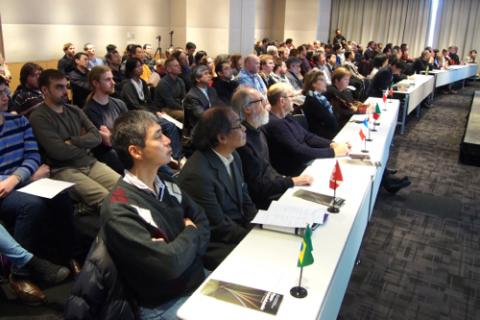
The Institute for Cosmic Ray Research signs an MOU with KEK on the Hyper-Kamiokande proto-collaboration
On January 31st, 2015, the Inaugural Symposium of the Hyper-Kamiokande Proto-Collaboration and Signing Ceremony was held at Kashiwa-no-ha Conference Center. The Hyper-Kamiokande project aims to address the mysteries of the origin and evolution of the Universe's matter and to confront theories of elementary particle unification. To realize these goals the project will combine a high intensity neutrino beam from the Japan Proton Accelerator Research Complex (J-PARC) with a new detector based upon precision neutrino experimental techniques developed in Japan. The Hyper-Kamiokande project will be about 25 times larger than Super-Kamiokande, the research facility that was first to discover evidence for neutrino mass in 1998.
TRIUMF’s Akira Konaka was the Master of Ceremonies for the event.
The symposium was held to commemorate and promote the proto-collaboration to advance the Hyper-Kamiokande project internationally. A signing ceremony marking an agreement for the promotion of the project between the Institute for Cosmic Ray Research (ICRR) of the University of Tokyo and the Institute of Particle and Nuclear Studies of the High Energy Accelerator Research Organization (KEK) took place during the symposium.
The symposium was attended by more than 100 Hyper-Kamiokande researchers including an international steering committee and an institutional board of representatives with members from 13 countries to celebrate the event. The Hyper-Kamiokande Member States: Brazil, Canada, France, Italy, Japan, Korea, Poland, Portugal (observer state), Russia, Spain, Switzerland, UK, USA.
The Hyper-Kamiokande proto-collaboration will include an international steering committee and an institutional board of representatives with members from 13 countries. Through this organizational structure collaborating researchers will work to lay plans for and to secure funding for the prompt realization of the experiment.
|  |
About the Hyper-Kamiokande Project
The Hyper-Kamiokande project seeks to reveal the full nature of neutrino masses and their mixing using both a high intensity neutrino beam from J-PARC and a new megaton-class water Cherenkov detector to succeed Super-Kamiokande. In particular, the project aspires not only to discover CP violation (particle-antiparticle asymmetry) in neutrinos, but to close in on theories of elementary particle unification with the world’s first discovery of proton decay. Expanding solar, atmospheric, and cosmic neutrino observations, as well as advancing neutrino interaction research and neutrino astronomy at Hyper-Kamiokande will provide new knowledge to particle and nuclear physics, cosmology, and astronomy. As an international project, researchers from around the world are working to start the Hyper-Kamiokande experiment in 2025.
About the Hyper-K Detector
Hyper-Kamiokande will be a megaton-scale underground water vessel lined with approximately 100,000 extremely high performance photosensors, making it the world’s largest neutrino and proton decay detector. While this detector is a “microscope” for observing elementary particles, it is at the same time a “telescope” that can observe the interior of the sun and supernova using neutrinos. In comparison to the current experiment, Super-Kamiokande, it will have 20 times the ability to detect neutrinos and is expected to discover differences in the properties of neutrinos and antineutrinos, known as CP violation (particle-antiparticle asymmetry). Further, with many more protons to observe it aims to discover rare proton decay phenomena. The world’s most sensitive and precise large-aperture photosensors, with 50% more sensitivity than those used in Super-Kamiokande, will be installed within the inner volume of the water vessel. These sensors are one of the important elements contributing to the realization of this world-leading detector.
For more information about Hyper-Kamiokande please visit http://www.hyper-k.org/en/symposium-20150131.html
 |  |
| Fig. 1: Illustration of Hyper-Kamiokande detector. | Fig 2. Developing ultrasensitive photodetectors for Hyper Kamiokande. The top left image shows a new large-aperture high-sensitivity "hybrid" photodetector, which uses a semiconductor called an "avalanche diode" for signal amplification. In the top right image a high-sensitivity photomultiplier tube is shown. The signal amplification stages of each photosensor appear in the bottom panel. |
–Content taken from the Institute for Cosmic Ray Research press release. Photo credits to Hyper-Kamiokande Collaboration.

